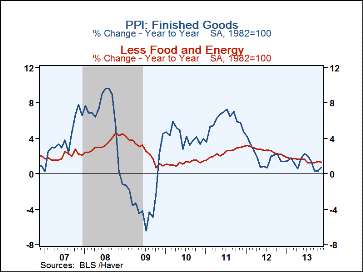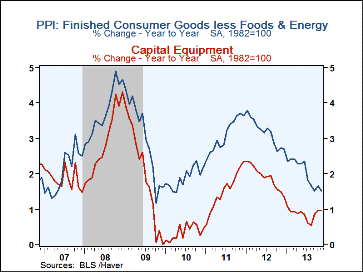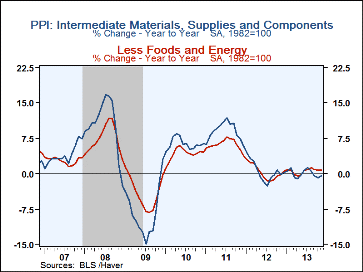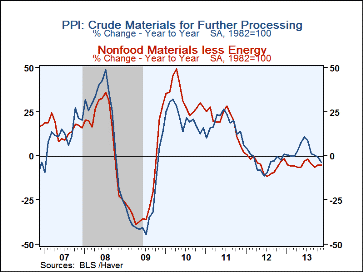 Global| Dec 13 2013
Global| Dec 13 2013U.S. Producer Price Index Slips With Energy Price Decline
by:Tom Moeller
|in:Economy in Brief
Summary
Price inflation at the wholesale level is virtually nonexistent. The Producer Price Index for finished goods slipped 0.1% last month (+0.7% y/y) following an unrevised 0.2% October decline. A 0.1% uptick had been expected in the [...]
Price inflation at the wholesale level is virtually nonexistent. The Producer Price Index for finished goods slipped 0.1% last month (+0.7% y/y) following an unrevised 0.2% October decline. A 0.1% uptick had been expected in the Action Economics survey. Prices excluding food & energy matched expectations and ticked up 0.1% in November (1.3% y/y) after a 0.2% rise during the prior month.
Food prices were unchanged (0.6% y/y). Fresh and dry vegetables prices surged by one-third y/y while fresh egg costs gained 6.5% y/y. Dairy product prices fell 1.4% y/y as beef & veal prices were off 4.2% y/y. Energy prices fell 0.4% (-0.6% y/y). The decline was led by a 5.7% shortfall (-4.2% y/y) in home heating oil costs and a 0.7% slip (-4.6% y/y) in gasoline prices. Residential electric power costs gained 0.2% (2.2 y/y) while natural gas prices improved a minimal 0.1% (4.7% y/y).
Finished consumer goods prices excluding food & energy were unchanged (1.5% y/y) and have been for four months. Consumer durable goods prices ticked up 0.1% for a second month (0.7% y/y) but passenger car prices retreated 0.8% (-0.3% y/y). Household appliance prices gained 0.2% (-0.7% y/y). Core consumer nondurable goods prices were unchanged (2.2% y/y). Capital equipment prices nudged up 0.1% for a second month (1.0% y/y).
Intermediate goods prices were off 0.5% (-0.5% y/y) led by a 1.5% decline (-3.1% y/y) in energy costs. Intermediate food prices moved 0.9% lower (-4.1% y/y). Prices excluding food & energy again slipped 0.1% (+0.8% y/y). Crude goods prices declined 2.6% (-3.3% y/y) led by a 6.6% shortfall (+0.6% y/y) in energy prices. Crude food prices were off 0.3% (-5.8% y/y). Crude goods prices excluding food & energy improved 1.4% (-5.3% y/y).
The PPI data are contained in Haver's USECON database with further detail in PPI and PPIR. The expectations figures are available in the AS1REPNA database.
Comments on Monetary Policy by Richard W. Fisher, President, Federal Reserve Bank of Dallas can be found here.
| Producer Price Index (%) | Nov | Oct | Sep | Nov Y/Y | 2012 | 2011 | 2010 |
|---|---|---|---|---|---|---|---|
| Finished Goods | -0.1 | -0.2 | -0.1 | 0.7 | 1.9 | 6.0 | 4.2 |
| Less Food & Energy | 0.1 | 0.2 | 0.1 | 1.3 | 2.6 | 2.4 | 1.2 |
| Foods | 0.0 | 0.8 | -1.0 | 0.6 | 2.6 | 6.3 | 3.9 |
| Energy | -0.4 | -1.5 | 0.5 | -0.6 | -0.2 | 15.5 | 13.5 |
| Intermediate Goods | -0.5 | -0.4 | 0.1 | -0.5 | 0.5 | 9.0 | 6.4 |
| Less Food & Energy | -0.1 | -0.1 | 0.1 | 0.8 | 0.3 | 6.2 | 4.3 |
| Crude Goods | -2.6 | -0.9 | 0.5 | -3.3 | -3.3 | 17.4 | 21.3 |
| Less Food & Energy | 1.4 | -0.5 | -1.0 | -5.3 | -5.2 | 18.5 | 32.5 |
Tom Moeller
AuthorMore in Author Profile »Prior to joining Haver Analytics in 2000, Mr. Moeller worked as the Economist at Chancellor Capital Management from 1985 to 1999. There, he developed comprehensive economic forecasts and interpreted economic data for equity and fixed income portfolio managers. Also at Chancellor, Mr. Moeller worked as an equity analyst and was responsible for researching and rating companies in the economically sensitive automobile and housing industries for investment in Chancellor’s equity portfolio. Prior to joining Chancellor, Mr. Moeller was an Economist at Citibank from 1979 to 1984. He also analyzed pricing behavior in the metals industry for the Council on Wage and Price Stability in Washington, D.C. In 1999, Mr. Moeller received the award for most accurate forecast from the Forecasters' Club of New York. From 1990 to 1992 he was President of the New York Association for Business Economists. Mr. Moeller earned an M.B.A. in Finance from Fordham University, where he graduated in 1987. He holds a Bachelor of Arts in Economics from George Washington University.










